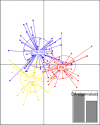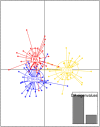Maternal supplementation with phytogenic additives influenced the faecal microbiota and reproductive potential in sows
- PMID: 34264424
- PMCID: PMC8282833
- DOI: 10.1186/s13568-021-01268-8
Maternal supplementation with phytogenic additives influenced the faecal microbiota and reproductive potential in sows
Abstract
Sows undergo physiological stress during gestation and lactation, potentially leading to enteric dysbiosis and reduced reproductive potential. Phytogenic additives (PFs) may improve performance via their antioxidant, anti-inflammatory and antimicrobial properties. This study determined whether the provision of a gestation/lactation diet containing PAs would alter the gastrointestinal microbiota of sows and their piglets, and improve performance. Sows received a commercial diet throughout gestation and lactation (CTR; n = 64), a commercial diet throughout gestation and a diet containing PAs in lactation (CTR-PA; n = 63) or a commercial diet containing PAs in gestation and lactation (PA; n = 90). Sows were weighed and backfat recorded after mating and at entry and exit from the farrowing house and piglets were weighed on days 1 and 21 of life. Faecal samples collected from sows at farrowing house entry and piglets at 21 and 35 d were subjected to 16 S rRNA gene amplicon analysis. The addition of PAs to sow diets resulted in more piglets born (P = 0.03), however, it did not improve the number of liveborn piglets (P = 0.14). There were no differences in sow weight, P2 backfat depth or lactation feed intake observed. PAs had no effect on piglet weight or survival to weaning but did alter the faecal microbiota of sows, and this change was observed in piglets at 21 and 35 d. PA supplementation to sows has the potential to increase litter size, while also potentially influencing gastrointestinal tract health of the sow and piglets reared.
Keywords: Bacteria; Gut health; PFA; Pig; Production.
© 2021. The Author(s).
Conflict of interest statement
The authors declare no other conflicts of interest.
Figures







References
Grants and funding
LinkOut - more resources
Full Text Sources

